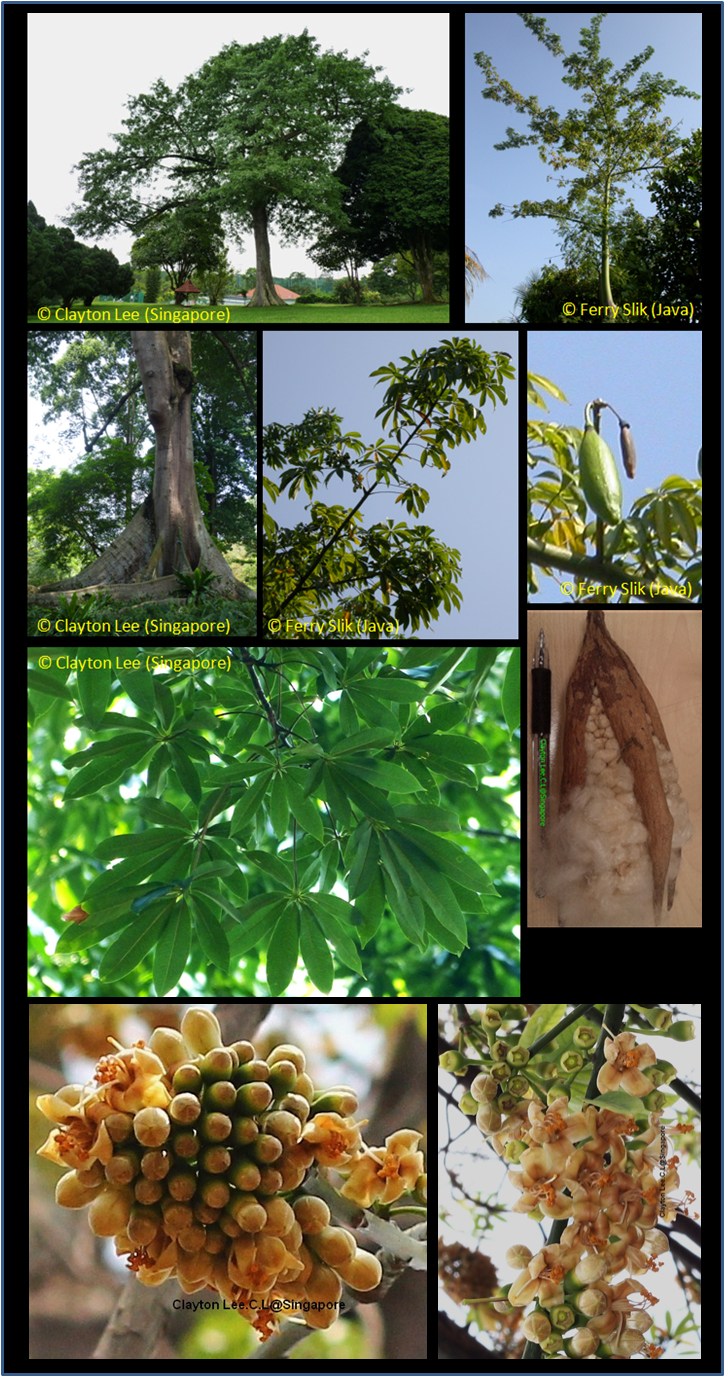Ceiba pentandra (L.) Gaertn., Fruct. Sem. Pl. 2: 244 (1791)
Latin for "five male parts", referring to the stamens.Synonyms
Bombax cumanense Kunth
Bombax guineense Schum. & Thonn.
Bombax guineensis Schumach.
Bombax inerme L.
Bombax mompoxense Kunth
Bombax occidentale Spreng. [Illegitimate]
Bombax orientale Spreng.
Bombax pentandrum L.
Bombax pentandrum Jacq.
Ceiba anfractuosa (DC.) M.G¨Žmez
Ceiba caribaea (DC.) A.Chev.
Ceiba casearia Medik.
Ceiba guineensis (Thonn.) A.Chev.
Ceiba guineensis var. ampla A. Chev.
Ceiba guineensis var. clausa A. Chev.
Ceiba occidentalis (Spreng.) Burkill
Ceiba pendrandra forma grisea Ulbr.
Ceiba pentandra forma albolana Ulbr.
Ceiba pentandra var. caribaea (DC.) Bakh.
Ceiba pentandra var. clausa Ulbr.
Ceiba pentandra var. dehiscens Ulbr.
Ceiba pentandra forma grisea Ulbr.
Ceiba pentandra var. indica Bakhuisen
Ceiba thonnerii A. Chev.
Ceiba thonningii A.Chev.
Eriodendron anfractuosum DC.
Eriodendron anfractuosum var. africanum DC.
Eriodendron anfractuosum var. caribaeum DC.
Eriodendron anfractuosum var. guianense Sagot
Eriodendron anfractuosum var. indicum DC.
Eriodendron caribaeum G.Don
Eriodendron caribaeum G. Don ex Loud.
Eriodendron guineense G. Don ex Loud.
Eriodendron occidentale (Spreng.) G.Don
Eriodendron orientale Kostel.
Eriodendron pentandrum (L.) Kurz
Gossampinus alba Buch.-Ham.
Gossampinus rumphii Schott & Endl.
Xylon pentandrum Kuntze
Diagnostics
Large trees, usually without buttresses. Bark sparsely spiny and generally smooth, often green when
young. Stipules present, but dropped early. Leaves palmately compound with c. 15 cm long petiole and
5-9 leaflets, leaflets with short petiolules (c. 4 mm), glabrous. Large pink-white flowers (c. 8 cm
diameter) with large stamens. Fruit a dehiscent woody capsule, c. 15 cm long, exposing many small hairy
seeds.
Description
Trees to 70 m tall and 3 m diameter; buttresses absent or present, trunk often sparsely spiny; main
branches verticillate, spreading horizontally; young branches spiny. Petiole 7-14(-25) cm, longer
than leaflet blade; leaflets 5-9, petiolules 3-4(-10) mm; blades oblong to lanceolate, 5-20 by
1.5-6.5 cm, thinly leathery, glabrous, base acuminate, margin entire or very sparsely and minutely
toothed near apex, apex shortly acuminate. Flowers subterminal, solitary or in fascicles of up to 15,
produced before or simultaneous with new leaves. Pedicel (1.8-)2.5-5 cm. Calyx (0.9-)1.2-2 cm,
adaxially glabrous. Petals pink or white, obovate-oblong, 2.5-4 x 0.7-1.5 cm, abaxially densely white
villous, adaxially glabrous. Filaments on staminal tube varying in length; anthers reniform. Ovary
glabrous; style 2.5-3.5 cm; stigma rod-shaped, 5-lobed. Capsule oblong, tapering toward tip, 7.5-15(-26)
by 3-5(-11) cm, fruiting pedicel 7-25 cm, endocarp leathery, smooth. Seeds globose, ca. 6 mm in diam.
[from Flora of China]
Ecology
Cultivated in Asia, but sometimes escaped or invasive (Pacific Islands). In Asia usually along roads,
in villages or open places.
Uses
This species is grown as a street tree and for the waterproof fibers surrounding the seeds (kapok). The fibre is light, very buoyant, resilient and
resistant to water. The process of harvesting and separating the fibre is labour-intensive and manual. It is difficult to spin but is used as an
alternative to down as filling in mattresses, pillows, upholstery, zafus, and stuffed toys such as teddy bears, and for insulation. It was previously
much used in life jackets and similar devices until synthetic materials largely replaced the fibre. The seeds produce an oil used locally in soap and
that can be used as fertilizer. Native tribes along the Amazon River harvest the kapok fibre to wrap around their blowgun darts. The fibres create a
seal that allows the pressure to force the dart through the tube. Ceiba pentandra bark decoction has been used as a diuretic, aphrodisiac, and to
treat headache, as well as type II diabetes. Ceiba pentandra is used as an additive to some versions of the hallucinogenic drink Ayahuasca. A pressed
seed oil can be derived from the seeds of the kapok tree. The oil has a yellow colour and a pleasant, mild odour and taste. It has similar characteristics
to cottonseed oil. It becomes rancid quickly when exposed to air. Kapok oil is produced in India, Indonesia and Malaysia. It has an iodine value of
85-100, which makes it a nondrying oil. This means that it does not dry out significantly when exposed to the air. Kapok oil has some potential as a
biofuel and in paint preparation.
Distribution
Originally from South America or possibly West Africa. Now pan-tropical. The commercial tree is most heavily cultivated in the rainforests of Asia,
notably in Java (hence its nicknames), Philippines, Malaysia, Hainan Island in China as well as in South America.
Local names
China: Ji bei.
Malay/Indonesia: Java kapok, Kapok.
